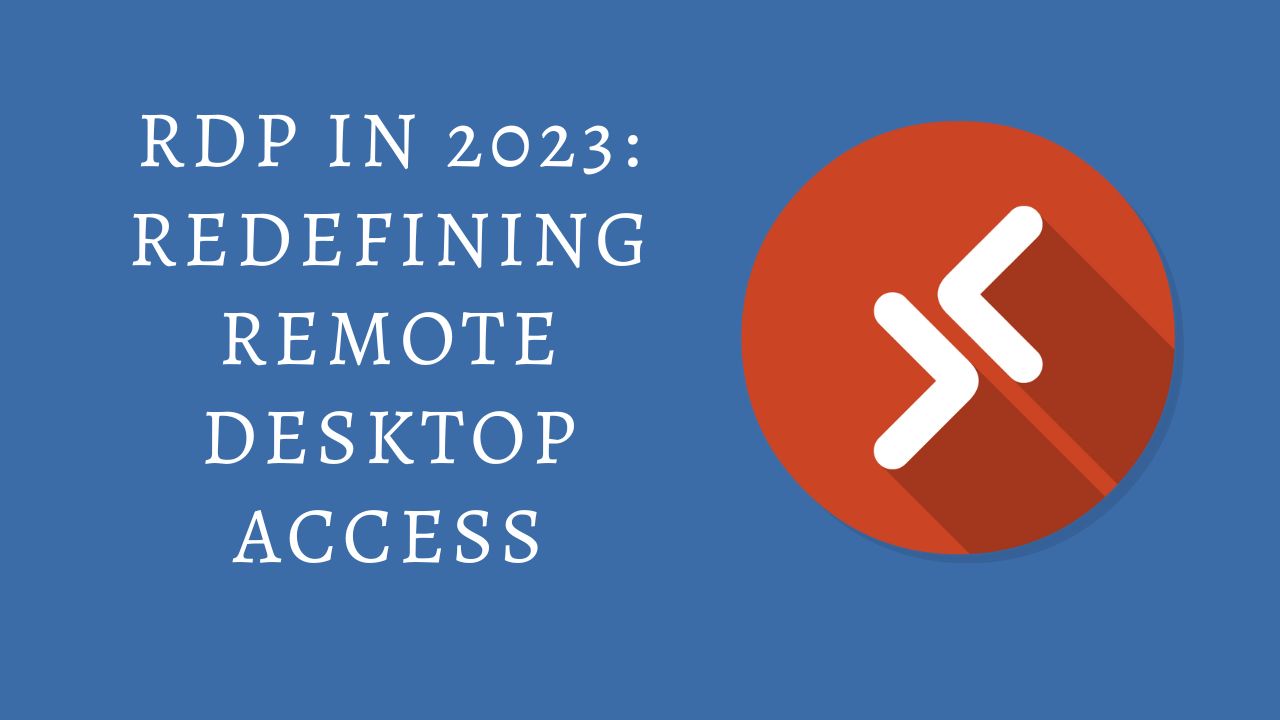
RDP in 2023: Redefining Remote Desktop Access
In today’s digital age, remote work and collaboration have become the new norm. Whether you’re a professional working from home, a student attending virtual classes, or a business owner managing a distributed team, remote desktop access has become a critical component of our daily lives. One of the most widely used and trusted technologies for remote desktop access is Remote Desktop Protocol (RDP). In this blog, we’ll explore the state of RDP in 2023 and how it continues to evolve to meet the growing demands of a connected world.
Enhanced Security
Security has always been a top concern when it comes to remote desktop access, and the RDP landscape in 2023 reflects a renewed focus on ensuring robust security measures. With cyber threats becoming more sophisticated, RDP has responded with advanced security features such as multifactor authentication (MFA), encryption, and network-level authentication (NLA). These measures protect against unauthorized access, data breaches, and man-in-the-middle attacks, providing users with peace of mind and reinforcing the trustworthiness of RDP.
Seamless Cross-Platform Compatibility
As the number of devices and operating systems continues to expand, RDP has adapted to provide seamless cross-platform compatibility. Whether you’re using Windows, macOS, Linux, or even mobile platforms like iOS and Android, RDP allows you to access your remote desktop from any device with an internet connection. The versatility of RDP in accommodating diverse operating systems has been a game-changer, enabling users to work and collaborate from anywhere, regardless of their device preferences.
Improved Performance and Speed
In 2023, RDP has made significant strides in improving performance and speed. By leveraging advancements in network technology and compression algorithms, RDP now offers smoother remote desktop experiences, even over low-bandwidth connections. Users can now enjoy faster response times, reduced latency, and enhanced graphical capabilities, making remote work and collaboration as seamless as if they were physically present at their remote desktops.
Enhanced Collaboration Features
Collaboration lies at the heart of remote work, and RDP has recognized the importance of facilitating teamwork and cooperation. In 2023, RDP solutions have integrated features such as file sharing, screen sharing, and collaborative annotation tools, allowing multiple users to work together on the same remote desktop simultaneously. These collaborative features have transformed remote meetings, presentations, and group projects, fostering a sense of connectedness among team members regardless of their physical locations.
Cloud Integration and Virtualization
The rise of cloud computing has had a profound impact on RDP. In 2023, RDP has seamlessly integrated with cloud platforms, enabling users to access virtualized desktops and applications from anywhere. By leveraging the power of cloud computing, RDP provides scalability, flexibility, and centralized management for businesses of all sizes. Virtual desktop infrastructure (VDI) solutions powered by RDP have become increasingly popular, allowing organizations to reduce hardware costs, improve data security, and streamline IT management.
The Future of RDP
Looking ahead, the future of RDP appears promising. As technology continues to advance, we can expect further enhancements in security, performance, and collaboration features. RDP may incorporate artificial intelligence (AI) and machine learning (ML) algorithms to provide predictive behavior analysis, proactive threat detection, and intelligent user experiences. Additionally, the integration of augmented reality (AR) and virtual reality (VR) technologies may transform how we interact with remote desktops, further blurring the lines between physical and virtual workspaces.
Overall, In the fast-paced world of remote work and collaboration, RDP remains a reliable and indispensable tool in 2023. With its enhanced security measures, cross-platform compatibility, improved performance, and collaborative features, RDP continues to redefine the way we access and interact with remote desktops. As we move forward, we can anticipate further innovation and integration of RDP with emerging technologies, ensuring that remote work becomes more seamless, efficient, and immersive than ever before.
Remote Desktop Protocol (FAQ)
Is RDP secure for remote desktop access?
RDP has significantly improved its security measures in 2023. It now offers features such as multifactor authentication (MFA), encryption, and network-level authentication (NLA) to protect against unauthorized access and data breaches. However, it’s essential to implement best practices, such as using strong passwords, regularly updating RDP software, and ensuring the security of the devices involved, to maintain a secure remote desktop environment.
Can I use RDP on different operating systems?
Yes, RDP has evolved to provide seamless cross-platform compatibility. Whether you’re using Windows, macOS, Linux, or mobile platforms like iOS and Android, you can access your remote desktop using RDP. This versatility allows users to work and collaborate across various devices and operating systems, making remote work more flexible and accessible.
How has RDP improved performance in 2023?
RDP has made significant advancements in performance and speed. Through the utilization of improved network technology and compression algorithms, RDP now offers faster response times, reduced latency, and enhanced graphical capabilities. These improvements ensure a smoother remote desktop experience, even when using low-bandwidth connections, making remote work and collaboration more efficient and seamless.
What are the benefits of RDP's integration with cloud computing?
The integration of RDP with cloud computing has brought numerous benefits. By leveraging cloud platforms, RDP enables users to access virtualized desktops and applications from anywhere with an internet connection. This integration offers scalability, flexibility, and centralized management for businesses. It allows organizations to reduce hardware costs, improve data security, and streamline IT management by leveraging virtual desktop infrastructure (VDI) solutions powered by RDP.


